
Features
Structural
Training
Back to Basics: The art of low profiling
SCBA is one of our most important pieces of equipment. It protects us from IDLH (immediate danger to life and health) atmospheres and has been considered the key in the advancement of today’s fire service.
June 1, 2009
By Mark Van Der Feyst
SCBA is one of our most important pieces of equipment. It protects us from IDLH (immediate danger to life and health) atmospheres and has been considered the key in the advancement of today’s fire service.
SCBAs have evolved but still have limitations: they limit our vision – especially peripheral vision; they limit our ability to communicate and to hear; they add weight; and they provide a limited air supply.
In addition, SCBAs add extra profile to our bodies, which hinders our ability to move around or through obstacles. In basic training, we were presented with an obstacle and were required to reduce our profiles so we could pass through it. This technique, called low profiling, is now being taught in firefighter survival classes as a method of self-rescue. Low profiling was around well before firefighter survival training started to emerge and we should all know and practise it. We take risks whenever we reduce our profiles. Normally, we want to keep SCBAs on our backs at all times, from the moment we don our breathing apparatus until we come out of the structure. When we take off our SCBAs or partially remove them within an IDLH atmosphere, we increase the risk of exposure and we increase the chance that something can go wrong with the SCBA. If we fail to properly reduce our profile, our SCBAs can be lost or become tangled or we might drop them through a hole in the floor, thus losing our air supply. All of these risks need to be eliminated or managed, and the only way to manage them is to become familiar with low profiling.
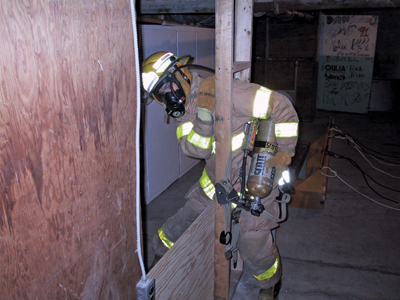 |
|
| Photo 1: Removing the SCBA | |
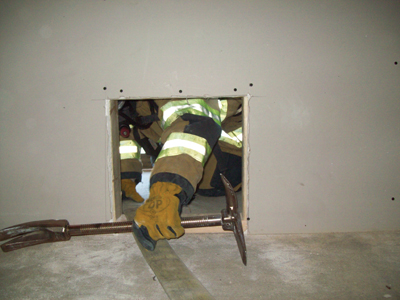 |
|
| Photo 2: Sounding the floor |
|
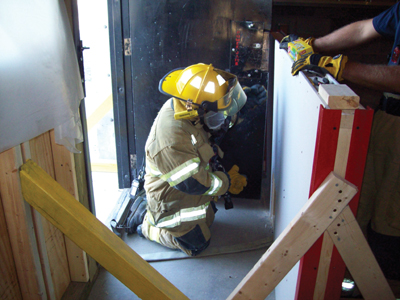 |
|
| Photo 3: Protect the regulator |
|
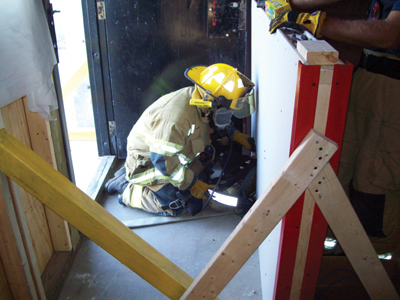 |
|
| Photo 4: Pass SCBA through opening | |
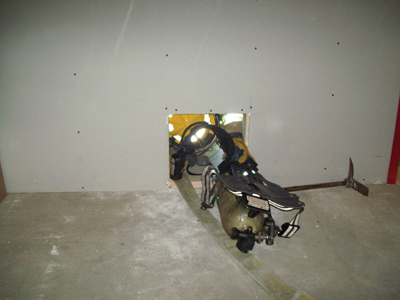 |
|
| Photo 5: Tool strategically placed by the wall |
|
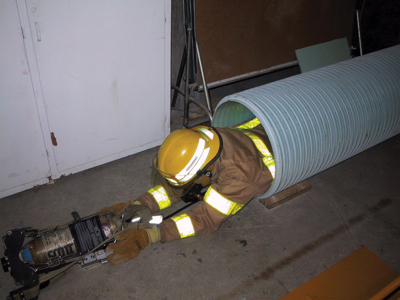 |
|
| Photo 6: Less-than-perfect |
|
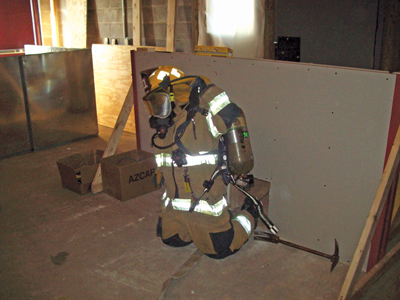 |
|
| Photo 7: Putting SCBA back on (Photos by Mark van der Feyst) Advertisement
|
■ There are three ways to reduce profile
1. Simply loosen the straps of the SCBA but keep it on. Loosening all the waist and shoulder straps allows the SCBA to move freely on our back so we can navigate through a small opening. Once we pass through the opening, we can tighten the straps and carry on. In a survival instance, re-tightening the straps is not that important because we want to exit the structure as fast as we can. In a search operation, it is prudent to re-tighten the straps. If the straps are not re-tightened, they can become an entanglement hazard and the SCBA could fall off – slowing us down, and making us ineffective.
We need to make sure we extend the straps all the way. Some firefighters loosen the straps just a little, which allows them to take off the SCBA or move it to one side but creates problems when it’s time to put the SCBA back on. Remember that we lose some dexterity and feel while wearing structural firefighting gloves. This hinders us when trying to put the SCBA back on. Opening the straps all the way ensures that we can get the SCBA back on quickly and efficiently.
2. The second method involves loosening the straps and taking off just one side of the SCBA. Look at photo 1.The firefighter has moved his SCBA to one side of his body and the profile allows him to fit through a tighter obstacle. Depending on the size of the firefighter to begin with, this may be the preferred method for reducing your profile. This technique requires all straps be loosened and one shoulder strap removed from your body. The shoulder strap that contains your regulator needs to stay on your body. This prevents the regulator from being pulled apart from the face piece.
In photo 1, the firefighter has the left shoulder strap on his body, thereby protecting his regulator. Once the SCBA is on the side of your body, you will be able to manoeuvre through the small space and bring the SCBA with you. Once through the obstacle, put the SCBA back on.
It is important to sound the floor when you are going through any type of an obstacle to make sure a floor exists – in other words, to make sure there isn’t a hole in the floor – to sustain your weight.
3. The third method is more risky. It involves removing the SCBA completely, passing it through the obstacle then putting it back on. As mentioned, the straps need to be fully extended.
In photo 2, the firefighter has an opening of just 14 inches by 14 inches through which to fit. He has used his tool to sound the floor on the other side of the wall and is aware that the floor is stable. This is important because if there is a hole in the floor the SCBA and regulator will fall through.
In photo 3, the firefighter has his SCBA off his back. He is wearing an MSA SCBA and protects the regulator by holding onto the right shoulder strap.
In photo 4, the firefighter passes his SCBA through the opening.
In photo 5, we can see from the other side of the wall how the SCBA is being passed through. The firefighter has a firm grip on his right shoulder strap to protect his regulator and make sure he does not lose the SCBA. Notice the tool lying next to the wall. It is placed here so the firefighter can easily locate it when he is ready to move on. Often firefighters throw the tool through the opening and let it land where it falls, making it difficult to find the tool.
Photo 6 shows another example of an SCBA being passed through an opening. This firefighter does not have a firm grip on the SCBA. He is holding it with both hands on the side, pushing it in front of him. Is he sounding the floor? Are there any holes in front of him? Be sure you have a firm grip on the shoulder strap that contains the regulator.
In photo 7 the firefighter has made his way through the opening and puts his SCBA back on.
The 14 by 14-inch opening is typical given that stud walls are spaced 16 inches apart.
For a useful drill, create a 14 by 14-inch hole and make everyone go through it at least once. You will be surprised that even the biggest person in your department will fit through using low profiling. This type of drill is also a good confidence builder for each person.
Mark van der Feyst is a 10-year veteran of the fire service currently working for the City of Woodstock Fire Department in Ontario. Mark is an international instructor teaching in Canada and the U.S. He is a local level suppression instructor for the Pennsylvania State Fire Academy and an Instructor for the Justice Institute of B.C. He can e reached at mvanderfeyst@gmail.com
Print this page